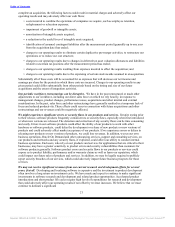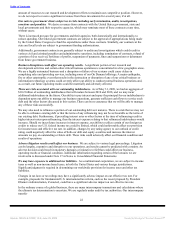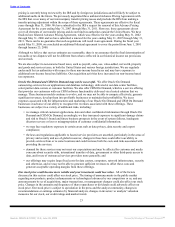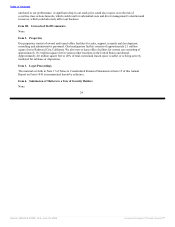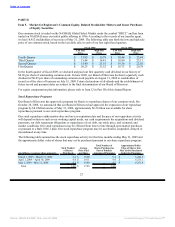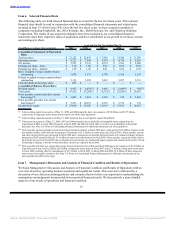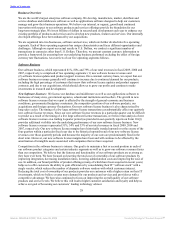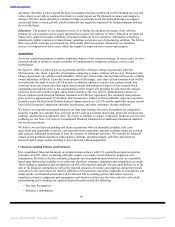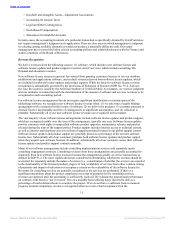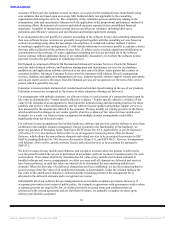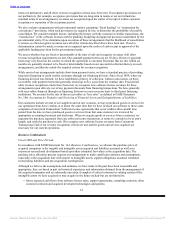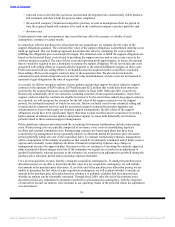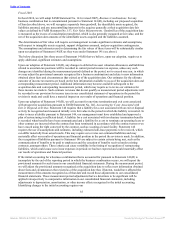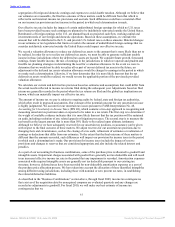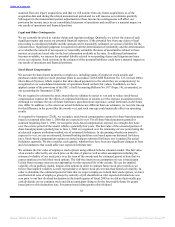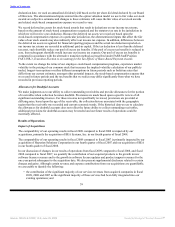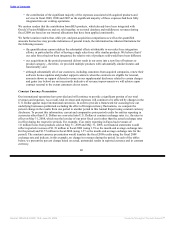Oracle 2008 Annual Report Download - page 36
Download and view the complete annual report
Please find page 36 of the 2008 Oracle annual report below. You can navigate through the pages in the report by either clicking on the pages listed below, or by using the keyword search tool below to find specific information within the annual report.
Table of Contents
• Goodwill and Intangible Assets—Impairment Assessments
• Accounting for Income Taxes
• Legal and Other Contingencies
• Stock-Based Compensation
• Allowances for Doubtful Accounts
In many cases, the accounting treatment of a particular transaction is specifically dictated by GAAP and does
not require management’s judgment in its application. There are also areas in which management’s judgment
in selecting among available alternatives would not produce a materially different result. Our senior
management has reviewed the below critical accounting policies and related disclosures with the Finance and
Audit Committee of the Board of Directors.
Revenue Recognition
We derive revenues from the following sources: (1) software, which includes new software license and
software license updates and product support revenues, and (2) services, which include consulting, On
Demand and education revenues.
New software license revenues represent fees earned from granting customers licenses to use our database,
middleware and applications software, and exclude revenues derived from software license updates, which
are included in software license updates and product support. While the basis for software license revenue
recognition is substantially governed by the provisions of Statement of Position (SOP) No. 97-2, Software
Revenue Recognition, issued by the American Institute of Certified Public Accountants, we exercise judgment
and use estimates in connection with the determination of the amount of software and services revenues to be
recognized in each accounting period.
For software license arrangements that do not require significant modification or customization of the
underlying software, we recognize new software license revenue when: (1) we enter into a legally binding
arrangement with a customer for the license of software; (2) we deliver the products; (3) customer payment is
deemed fixed or determinable and free of contingencies or significant uncertainties; and (4) collection is
probable. Substantially all of our new software license revenues are recognized in this manner.
The vast majority of our software license arrangements include software license updates and product support,
which are recognized ratably over the term of the arrangement, typically one year. Software license updates
provide customers with rights to unspecified software product upgrades, maintenance releases and patches
released during the term of the support period. Product support includes internet access to technical content,
as well as internet and telephone access to technical support personnel located in our global support centers.
Software license updates and product support are generally priced as a percentage of the net new software
license fees. Substantially all of our customers purchase both software license updates and product support
when they acquire new software licenses. In addition, substantially all of our customers renew their software
license updates and product support contracts annually.
Many of our software arrangements include consulting implementation services sold separately under
consulting engagement contracts. Consulting revenues from these arrangements are generally accounted for
separately from new software license revenues because the arrangements qualify as service transactions as
defined in SOP 97-2. The more significant factors considered in determining whether the revenue should be
accounted for separately include the nature of services (i.e., consideration of whether the services are essential
to the functionality of the licensed product), degree of risk, availability of services from other vendors, timing
of payments and impact of milestones or acceptance criteria on the realizability of the software license fee.
Revenues for consulting services are generally recognized as the services are performed. If there is a
significant uncertainty about the project completion or receipt of payment for the consulting services,
revenues are deferred until the uncertainty is sufficiently resolved. We estimate the proportional performance
on contracts with fixed or “not to exceed” fees on a monthly basis utilizing hours incurred to date as a
percentage of total estimated hours to complete the project. If we do not have a sufficient basis to measure
progress towards completion, revenue is recognized when we receive final acceptance from the
31
Source: ORACLE CORP, 10-K, June 29, 2009 Powered by Morningstar® Document Research℠


